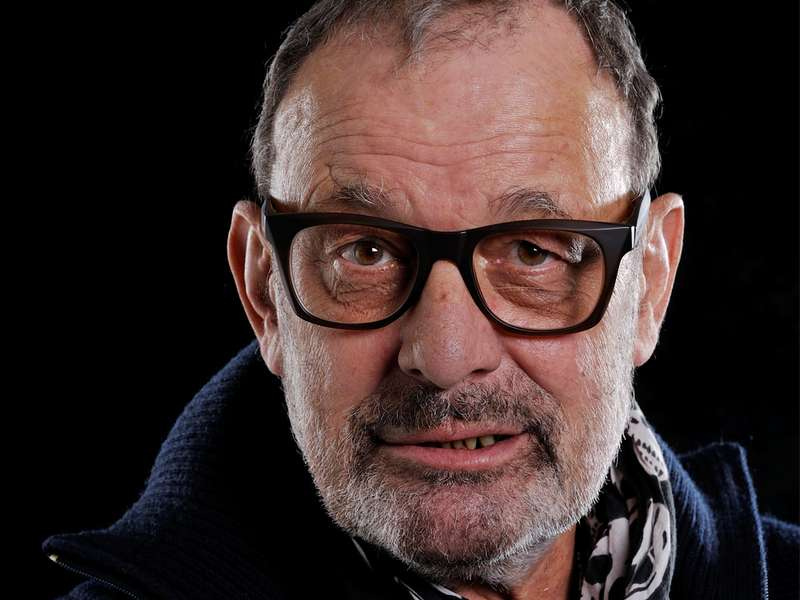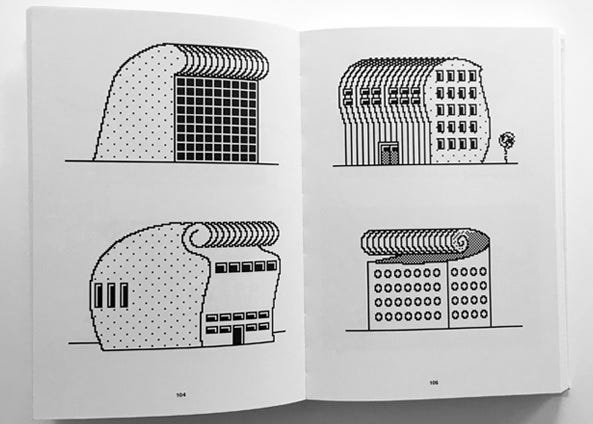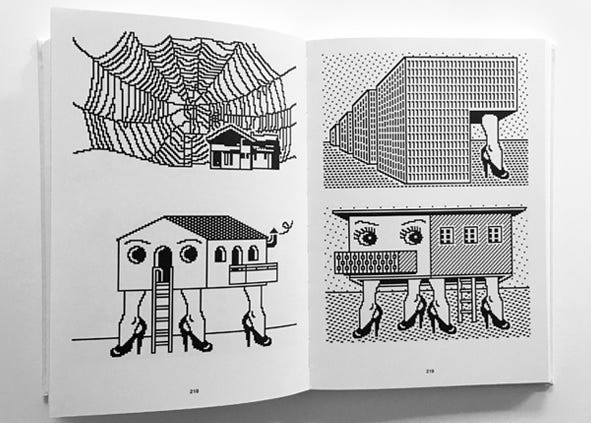so you wanna get into... anton bruhin
"At that time I realized that the jew's harp sounds like a synthesizer... its sound is quite similar to the Moog."

(photo by christian lanz via cafe oto)
welcome to issue #18 of “tusk is better than rumours,” a newsletter featuring primers and album rankings of experimental and ‘outsider’ musicians. artist primers are published every other monday, and on off-weeks i publish a variety of articles ranging from label and genre primers to interviews to guest writers.
this week we’ve got a primer on the work of anton bruhin, composer, visual artist, and virtuoso of the jew’s harp (or jaw harp, or mouth harp, or trümpi). bruhin’s career has spanned 50 years and includes major works in sound poetry, audio collage, and traditional jew’s harp music.
sign up to receive the newsletter if you haven’t already! and follow us on twitter @tuskisbetter! and tell a friend! also you can reply to these emails or write to tuskisbetter@gmail.com.
sometimes for a brief moment i forget about my lack of rhythm and my tin ear and what my doctor diagnosed as an “incurable amelodicism” and i think about learning an instrument. then i figure i should learn to play something obscure like a hexenscheit or a nyckelharpa because maybe i could win people over on sheer novelty alone. after all, there is no instrument so niche that there is not a dedicated international community built around it who would be excited to show me the ropes and i could take their advice and then go wow my rube friends who have never heard of a hurdy-gurdy much less seen one played. and i think this is it: i will become a Daxophone Guy or whatever. and then i remember that i have no ear for music and no patience and probably internet-related brain misworkings and i say ah well.
anton bruhin is an example of somebody who went and did just that. he saw a street musician playing a jew’s harp when he was 18 and asked the guy for a lesson and spent the rest of his life traveling the world playing the jew’s harp. what is a jew’s harp you ask? i’m glad you asked because honestly i had no idea either. it’s a tiny thing shaped a bit like a little guitar that has a straight piece of metal connected to the back of the “body” and extending through its “neck.” you play it with your mouth by blowing or humming through the hole in the body in some unaccountable way and flicking the long piece of metal with your finger. to me it sounds like a trebly didgeridoo, though bruhin insists it sounds like a synthesizer. i suppose sometimes it does sound like a vocoder. anyhow bruhin goes all over the world playing the jew’s harp with fellow aficionados. i watched a whole documentary about him and all he did was travel around from his native switzerland to siberia to japan playing the jew’s harp at events that looked more like family reunions than concerts.
normally when you write about a musician you do one of two things: you either talk about Their Thing, like reich’s phasing or monk’s extended vocal techniques, or you talk about Their Place in a Wider Movement, like radigue in ambient music or winderen in field recording. well with bruhin it’s a bit different because he doesn’t really have a Thing per se, as all of his albums sound wildly different from one another (the jew’s harp is more of an instrument than a Thing, and even still he doesn’t play it on all his records). he also doesn’t fit neatly into any Wider Movement—like i say, he’s more happy traveling to siberia to play in someone’s living room than partaking in any such scenes. this isn’t to cast him as some sort of mysterious outsider, as it’s clear he loves to collaborate, but rather to say that in the Yearbook of Experimental Music it’s not clear what clubs he would be a part of.
one way to get at his work is to look at his art. he’s a multimedia artist, producing paintings and illustrations and mosaics. he humorously takes on the “serious” history of art by remixing it with dated technology. take a look at these famous pictures by german photographers bernd and hilla becher:

(bernd and hilla becher, Engine Houses, 1986)
and compare to these images from a book by bruhin:


(from anton bruhin’s Pixelbildi, 2018)
the bechers’ self-serious “independent objective photography” in their Typologies series is paid a gently mocking homage in bruhin’s pixel-picture versions, which get more and more outlandish as the book progresses. where the bechers’ work is cold, even menacing, bruhin’s imaginary typology is whimsical and inviting. this is the move he makes with his music too. the jew’s harp, half instrument and half toy, can’t be played without a sense of humor. and in each of his records, he takes up the signifiers of some scene, from improvisation to sound poetry to tape music, and twists them just enough to make the scene seem goofy and accessible. artreview calls him an “artist’s artist,” and if by that is meant somebody performing to an audience who will get all the inside jokes, he’s certainly a musician’s musician as well.
bruhin was most productive in the 1970s, and he has had a resurgence in popularity centered around reissues of his work beginning in the late ‘90s. he has never stopped producing though, both in his visual art and frequently as a contributor to jew’s harp compilations from labels like ats and musica helvetica. below i’ve selected nine of his works, listed in order from most to least recommendable and divided in “major” and “minor” categories. dates refer to original composition/recording, not to re-releases. to explore his entire career as both a musician and a visual artist, i’ve found this cv from 2014 to be the most comprehensive listing of all of his work. stick around til the end when i’ll link to a long-form interview with bruhin at cafe oto and post my own mix of some choice selections from throughout his career.
Major Pieces
Vom Goldabfischer (1969)
almost as if to prove he can work in any mode right up front, bruhin explored a wide array of genres and instruments on this first album from 1969. though it has been reissued by alga marghen along with many of bruhin’s best, it’s difficult to find this album streaming in full (see the mix linked below for more selections from it). in the clip above, he plays the jew’s harp along with a lovely folk melody. it’s indicative of his lifelong love of the instrument, but not of how anything else on the album sounds. on other tracks he plays fiddle, harmonica, flute, an invented instrument called the ch-phon, water somehow, and sings along with guitarist stefan wittwer and bassist/cellist cristian koradi, creating an unpredictable mess of lo-fi experimental folk that earned him a spot on the nurse with wound list. this is a classic of that variety of skewed home recordings that get passed around with a fervent whisper of approval for decades before they reach a larger audience.
Rotomotor (1976-1978)
alga marghen also recently reissued this selection of pieces from the late ‘70s. the song “rotomotor” is definitely his masterpiece in the sound poetry tradition, and might also be his masterpiece in any genre. in it, he recites a list of words in swiss german, each one being one letter different from the previous. meanwhile a delay pedal plays back his recitation .6 seconds later, creating a doubled effect that further blurs the words together. the fact that he can keep it up for 28 minutes is impressive, and its overall effect even more so. this reissue also includes “orax,” a somewhat random piece of environmental sound, and three excerpts from his “mc-10 zyklus,” which consists of 12 ten-minute long songs for which he used two cassette recorders with loudspeakers to dub and overdub tracks. those latter aren’t pleasant to listen to, per se, but they are exemplary of bruhin’s method of working with cheap or broken equipment and pushing them as far as possible—a welcome invitation to experiment, especially in the age of ableton perfectionism.
Deux Pipes (1994-2000)
the first two tracks here are A+ gold-level all-time greatest hits. they each feature bruhin improvising with a jew’s harp over loops made with a child’s casio keyboard. the loops provide a solid ground over which bruhin can wander with his jew’s harp, trying out ideas as they come to him. like the cassette tracks of “mc-10 zyklus,” they reinsert a sense of play into the world of minimalist loop-splicing. the third track, “maultrommel und sprache” (mouth harp and speech) is bruhin’s experiment in speaking through the jew’s harp. the effect is of an acoustic vocoder that gets more and more sophisticated as he moves from simple vowels a-e-i-o-u to diphthongs to triphthongs. the final three tracks are experiments with the “electric-trumpi-2,” an electric jew’s harp designed by zoltan szilagyi. here bruhin comes as close as he ever has to proving his contention that the jew’s harp sounds like a synthesizer—put this on and ask somebody what instrument it is and i guarantee they’ll guess it’s some sort of primitive modular setup.
InOut (1976-1981)
the title track here is a classic of tape music, an insane 23-minute piece that sounds like switching tv channels really fast in a cartoon world. the other three tracks are of varying quality, with the second song “musik, vielleicht fur sie” (music, perhaps for you) consisting of another 23 minutes of much less insane doodling on wind instruments. and then there’s “wochenende,” made in much the same way as “inout” except without its manic speed. the collection ends with “die welt,” which was recorded “on a cassette recorder equipped with almost used up batteries.” a chipmunk sings in german atop a meandering detuned piano. it strikes me now that if bruhin decided at some point in the late ‘70s to follow up with any of these leads described above—freaky experimental folk, longform sound poetry, lo-fi tape manipulation—instead of dedicating himself to jew’s harp and painting, he could have made significant headway in the world of experimental music. then again, if he had done that then he wouldn’t be anton bruhin the goofball amateur, but just another voice in a crowded field. his appeal is in his willingness to experiment, the catch being that as soon as he perfects one medium, as in “rotomotor” or “inout,” he’s off to another experiment.
Minor Pieces
Neun Improvisierte Stücke 1974 / Rotomotor 1978 (1978)
i talked about the great “rotomotor” up there, and this is where it was originally released. the reason it’s down here in the “minor pieces” category is that the accompanying pieces, nine short improvisations with stefan wittwer (who also played on Vom Goldabfischer), don’t stack up to those featured on the alga marghen reissue. they feature an intriguing variety of sounds, as if the duo called in all favors to borrow every instrument they could and then set them up in the same room for the session. but they are largely aimless, featuring improvisational tricks like startling changes in dynamics (read: quiet then LOUD) without the directedness of Vom Goldabfischer’s deconstruction of genre.
Electric Eel (with Makigami Koichi) (1998)
this album, released by john zorn’s tzadik label, is usually listed as a makigami koichi solo album but really it’s a trio with him, bruhin on jew’s harp, and tadagawa leo on dromb and ilimba. koichi’s insane nonsense vocals are a great counterpart to the jew’s harp, which provides him a steady beat over which to babble and moan. bruhin extends his own playing here as well, especially on the bassy drone of “jubako.”
Vogelsang/Vogelsong/Vogelsung/Vögelsäng (1977)
in 1977 bruhin took the lead of his painter friend hans krüsi and recorded the birds around his house. unlike krüsi though, he then manipulated the recordings with reverb, delay, and distortion until they turned into a torrent of shrieking noise. it’s pretty good noise, all things considered, especially considering it predates merzbow’s bird-inspired noise by three decades. that being said, it lacks the charm and the humor that sets bruhin apart from those who operate in the same vein.
11 Heldengesänge & 3 Gedichte (1977)
in english this is “11 heroic songs and 3 poems,” and it consists of exactly that—bruhin came up with 11 imaginary medieval heroes and gave them stirring speeches (in german, so i don’t know what they have to say), each with a unique brass fanfare. then, three poems that have jazzy bass/piano/drum backing tracks. it’s very odd, might be better if you speak or understand german.
Anton Bruhin Spilt 'S Trümpi (1996)
the title for this one in swiss german is “anton bruhin plays the jew’s harp” and it does right what it says on the tin. if you’re already a fan of the jew’s harp or if you for some reason are an aspiring jew’s harp fan then this will be of interest as it features some of the most accomplished jew’s harp playing out there. for everybody else it’s something of a curiosity.
alright so that’s the lay of the land but wait wait! there’s even more bruhin a-brewin’. i’ve created a handy mix of bruhin’s best in an mp3 album that you can find here (grab it quick, link expires in one week on 5/25/20). and here is an interview that bruhin did at cafe oto relatively recently. he goes long and even plays a new piece at the end:
alright that’s it folks, see y’all next week.
you can help support the newsletter for the price of a coffee. all donations go toward paying occasional guest writers and offsetting the costs of production (bandcamp downloads, food, stimulants)


